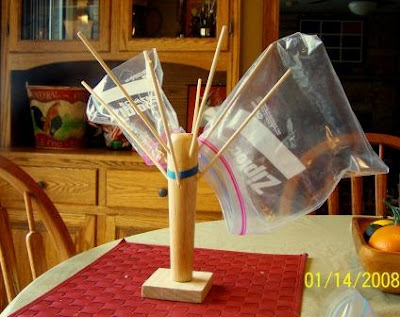


Congee.
One way to incorporate frugal zen into your food bugdet, is to explore ethnic foods. If you have access to a farmer's market or an ethnic market like Asian or Mexican, you can often purchase cheap ingredients and make fantastic meals. Most of my ancestors come from Europe, but my husband was born in Bangkok, Thailand. It is really easy, almost imperative, that I add Asian dishes to our menus. My mother-in-law has taught me some really good dishes, but some of my favorites are the cheapest and easiet.
Congee is actually a Chinese name for this Asian common breakfast or dinner. It can be found at Dim Sum houses in China town here in Chicago. Most Thai's I know eat this for breakfast or a late night snack, but I love it for a quick, nutritious, filling dinner.
Rice. The most important part of a Congee Dinner. I either use left over rice or uncooked rice. Place rice in a saucepan and add way too much water. It will turn out soupy, and that is what you want. It's actually a rice porridge, but I don't like the way that sounds, so I use the Chinese name congee. If I have 2 cups cooked rice, I would add 2 cups water and heat to boiling. I might or might not add more water depending on the consistency desired. There is no right or wrong consistency, I like mine a little less soupy than my husband does. I usually cook it to the consistency that I like, and then add a little hot water to my husband's bowl when I serve it.
Accompaniments. Served with the congee are an assortment of protein and veggies. I usually make a three egg omlette cooked in olive oil. When I am preparing the eggs, I add a tsp of fish sauce, or nam pla, but if you don't have access to it, a little salt will do just fine.
Immediately after the omlette is finished cooking, I throw 1/4 to 1/2 cup roasted, salted peanuts into the omlette pan. I don't turn off the heat, and toss the peanuts around the pan for 1 or 2 minutes until they just start to brown and you can smell the peanuts cooking. As soon as the peanuts are browned, pour them into a bowl. Don't let them burn. BE CAREFULL!!! These are very hot.
I also serve some preserved asian vegetables. I get these little cans at my local asian market, but if you can't find them, parboiled green beans, cooked carrots, or another cooked vegetable would be just fine. Note: if you can't find pickled veggies, add a little soy sauce to the congee. The brine from the pickled veggies gives a nice salty flavor that you will otherwise miss.
Another thing we like to eat is dried shredded pork. It looks a little like dryer lint, but it is really good with congee. It is sweet and a little salty and after rehydrating in the congee has a nice tender chewiness to it.
To eat your congee, place small bits of egg, veggies, pork, and a few peanuts in the bowl. Some people like to mix, but I usually don't and add more as I go.
This is actually quite filling, and it is very inexpensive to serve. The little cans of veggies usually cost 75cents or less, the dried pork is about 2 dollars - and it will last a while, you won't eat it all in one meal, and the rice, eggs and peanuts are nominal.
Enjoy!!!














